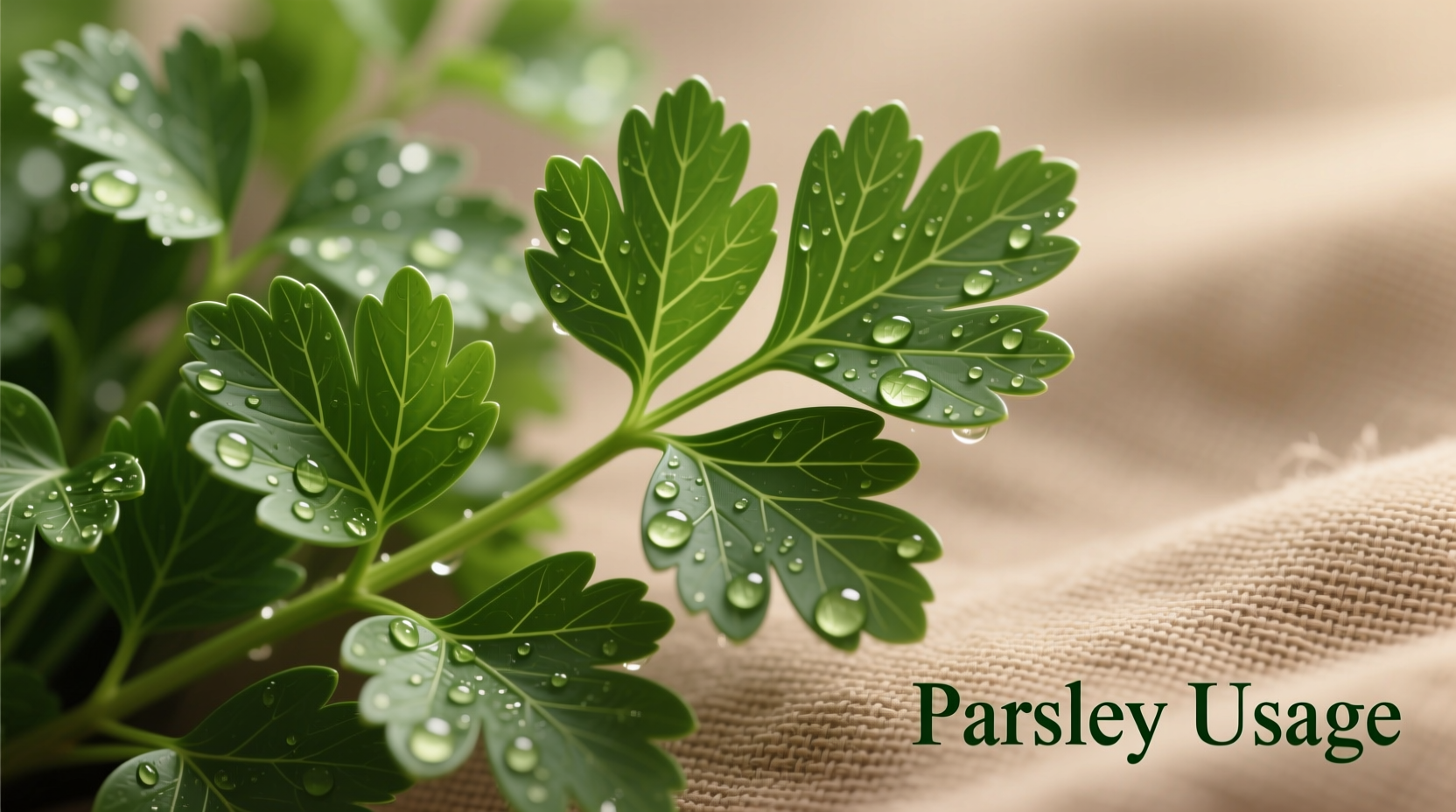Often relegated to the role of mere plate decoration, parsley is actually one of the most versatile and nutritionally valuable herbs in the culinary world. This unassuming green herb contains three times more vitamin C than oranges by weight and adds complex flavor to countless dishes when used properly. Understanding the proper usage of parsley transforms it from an afterthought to a kitchen essential.
Understanding Parsley Varieties and Their Best Applications
Not all parsley is created equal. Choosing the right variety for your culinary application makes a significant difference in flavor impact. Here's how the two main types compare:
| Characteristic | Flat-Leaf (Italian) Parsley | Curly Parsley |
|---|---|---|
| Flavor Profile | Bright, robust, slightly peppery | Milder, more delicate |
| Best Culinary Uses | Sauces, stews, marinades, pesto | Garnishes, salads, finishing dishes |
| Texture When Cooked | Holds shape well | Softens more quickly |
| Shelf Life | 7-10 days refrigerated | 5-7 days refrigerated |
Selecting and Storing Parsley for Maximum Freshness
Proper storage techniques can extend parsley's shelf life by up to two weeks, preserving both flavor and nutritional value. When selecting parsley at the market, look for vibrant green leaves without yellowing or wilting. The stems should be crisp and firm.
For optimal storage, treat parsley like cut flowers:
- Trim ½ inch from the bottom of stems
- Place in a glass with 1-2 inches of water
- Cover loosely with a plastic bag
- Store in refrigerator, changing water every 2-3 days
This method maintains parsley freshness significantly longer than traditional storage in plastic containers. Research from the University of California's Agriculture and Natural Resources department confirms that proper hydration extends herb shelf life by maintaining cellular structure and delaying wilting.
Practical Applications: How to Use Parsley Effectively in Cooking
Raw Applications for Maximum Flavor Impact
When using parsley raw, timing matters. Add it at the very end of preparation to preserve its bright flavor compounds. The best usage of parsley in raw applications includes:
- Gremolata: Combine equal parts minced parsley, lemon zest, and garlic for a vibrant topping for osso buco or roasted meats
- Chimichurri: Blend parsley with oregano, garlic, vinegar, and olive oil for a versatile Argentinian sauce
- Tabbouleh: Use flat-leaf parsley as the primary ingredient (not just a garnish) in this Middle Eastern salad
- Green sauces: Create vibrant herb sauces by blending parsley with capers, anchovies, and olive oil

Cooked Applications That Enhance Dishes
While many believe parsley loses all value when cooked, strategic use during cooking actually develops complex flavor compounds. The proper usage of parsley in cooked dishes includes:
- Flavor base addition: Add stems (finely chopped) to mirepoix or sofrito for soups and stews
- Finishing touch: Stir in whole leaves during the last 2 minutes of cooking for pasta sauces
- Roast enhancement: Place whole sprigs under chicken skin or alongside roasting vegetables
- Stock building: Include stems in vegetable or meat stock for additional herbal notes
Preservation Techniques for Year-Round Usage
Don't let excess parsley go to waste. These preservation methods maintain flavor for future culinary applications:
- Freezing in oil: Blend parsley with olive oil and freeze in ice cube trays for instant flavor additions to soups and sauces
- Drying method: Hang small bunches upside down in a dark, well-ventilated space (dried parsley works best in spice blends)
- Herb salt: Mix finely chopped parsley with sea salt and dry in a low oven for a flavorful finishing salt
According to research published in the Journal of Food Science, freezing herbs in oil preserves up to 90% of volatile flavor compounds compared to 60% retention with traditional drying methods.
Common Mistakes to Avoid with Parsley
Even experienced cooks make these parsley errors that diminish its culinary impact:
- Adding too early in cooking: Delicate flavor compounds break down with prolonged heat exposure
- Using only leaves: Stems contain concentrated flavor and should be utilized in stocks and sauces
- Washing and storing wet: Excess moisture accelerates spoilage—always dry thoroughly before storage
- Assuming all parsley is equal: Using curly when flat-leaf is needed (or vice versa) affects final dish flavor
Substitution Guidance When Parsley Isn't Available
While nothing perfectly replicates parsley's unique flavor profile, these substitutions work in specific contexts:
- For flat-leaf parsley: Cilantro (in Latin American dishes) or celery leaves (in soups)
- For curly parsley: Chervil or a combination of chives and tarragon
- When completely out of fresh herbs: Use ⅓ the amount of dried parsley in cooked dishes only
Remember that substitutions work best when matched to the dish's cultural context—using cilantro in Mediterranean recipes creates flavor dissonance, while chervil better maintains the intended profile.
Maximizing Nutritional Benefits Through Proper Usage
Parsley ranks among the most nutrient-dense herbs, containing significant amounts of vitamins K, C, and A. To maximize nutritional benefits:
- Add raw parsley to finished dishes rather than cooking it extensively
- Pair with healthy fats (like olive oil) to increase absorption of fat-soluble vitamins
- Use the entire plant—stems contain concentrated nutrients
- Consume within 7 days of purchase for peak nutritional value
The USDA National Nutrient Database confirms that just one-quarter cup of fresh parsley provides 200% of the daily recommended intake of vitamin K and 50% of vitamin C.











 浙公网安备
33010002000092号
浙公网安备
33010002000092号 浙B2-20120091-4
浙B2-20120091-4